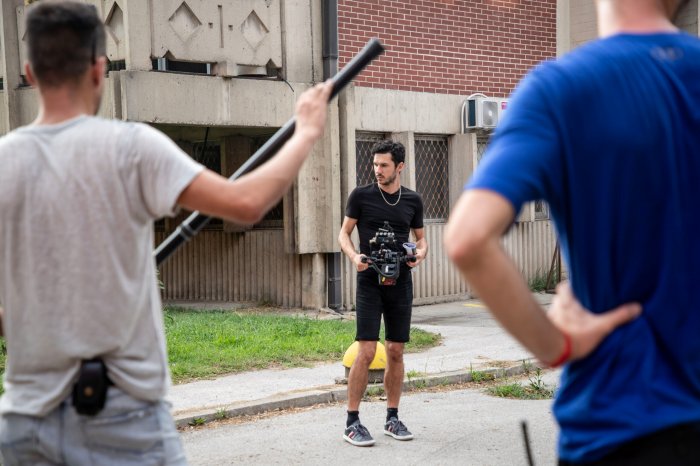It's hard to make generalizations about a program as broad as the 2008 lineup of “Film Comment Selects,” which ranges from zombie movies to experimental documentaries. As I noted last year, the series is far more open to provocation and potential controversy than its big brother, the New York Film Festival.
Much of this year's programming suggests an emerging “Europe Extreme” aesthetic, influenced by directors including Gaspar Noe and Michael Haneke. It's all over the program notes, which promise a “money-back guarantee that there's something to offend everyone” in the Belgian film “Ex-Drummer” and describe Austrian director Ulrich Seidl's “Import Export” as a “prime example of Abjection Cinema, the art-film genre of the moment.”
Provocation revisits Lincoln Center's “Film Comment Selects”.
The series offers a wide range of French cinema, from French New Wave great Jacques Rivette's latest film to Jacques Nolot's “Before I Forget,” a meditation on gay male aging, to two violent horror films, “Inside” and “Frontiere(s).” All but two of its selections come from the US and Europe.
Among the series' attractions are a handful of retrospectives. Two '70s films by Richard Fleischer will be shown, including the notorious “Mandingo.” Alex Cox will be presenting his 1987 Peckinpah-in-Nicaragua film maudit “Walker” and his latest film, “The Searchers 2.0.” A new distributor, the Film Desk, is using the series to launch its release of Philippe Garrel's 1991 elegy for his partner Nico, “J'entends plus la guitare.”
FILM COMMENT SELECTS
Walter Reade Theater
Lincoln Center
W. 65th St., btwn. Broadway & Amsterdam Ave.
Feb. 14-28
Schedule at filmlinc.com/wrt/wrt.htm
Julien Maury and Alexandre Bustillo's “Inside” ranks among the goriest films I've ever seen. However, as explicit as it is, it's hardly devoid of subtlety. The directors have learned a lot from Kiyoshi Kurosawa about the power of shadow and darkness to create a mood and provide a launch pad for shock effects. The narrative is extremely simple – pregnant photographer Sarah (Alysson Paradis), who has recently survived a car accident that killed her husband, is stalked around her house by a nameless woman (Béatrice Dalle) who wants to kill her and take her baby.
“Inside” taps into visceral, subconscious fears about maternity, including anxiety about killing one's own mother. Dalle makes a great villain; clad in black and wielding scissors, she's as iconic as Freddy Kruger or Jason Voorhees. Although the film was written and directed by men, the world of “Inside” is distinctly female, if not feminist. The hero and villain are both women, while the handful of men who show up prove themselves incapable of defending Sarah.
This exercise in dread has proved to be Maury and Bustillo's Hollywood calling card – their next film will be a remake of Clive Barker's “Hellraiser.” It deserves to scare American multiplex audiences, where I suspect it would anger as many people as it pleases – but unfortunately it's coming out straight-to-DVD, where its extremely dark cinematography is bound to suffer.
For those who don't want to see a pregnant woman getting terrorized, “Film Comment Selects” also offers the opportunity to luxuriate in breathtaking architecture sans bloodshed. German director Heinz Emigholz's “Schindler's Houses” surveys 40 LA buildings designed by Austrian-American architect Rudolph Schindler. Emigholz delivers an introduction in the opening scene, but the rest of the film is devoid of narration or other directorial intrusions because it expects Schindler's work to speak for itself, which it does.
Emigholz could have created a terrific gallery show of still images to accompany this film. He uses ten-second bursts from a static camera, surveying each house from several positions and generally avoiding panoramic views. In fact, he often films with a precariously titled camera and his perspective comes close to abstraction. Plants and material possessions have a stronger presence in the film than people, who are largely absent from Emigholz's vision.
Nevertheless, the spaces are clearly lived-in and altered by use. The film resembles less a conventional documentary than a collision between two modernist styles; watching it is like carefully examining a sculpture from all sides.
After premiering at Sundance in January 2007, Chen Shi-Zheng's “Dark Matter” saw its release plans shattered by its plot's parallels to the Virginia Tech murders that took place a few months later. Only in the past month has it found an American distributor. Based on a true story, it focuses on Liu Xing (Ye Liu), a brilliant Chinese grad student who comes to the US to study cosmology with the charismatic Professor Jacob Reiser (Aidan Quinn). The film's choice of a university setting for its exploration of the conformism inherent in assimilating to American culture is unique.
However, its ideas might have been better expressed through comedy than tragedy. For the first half hour, Chen keeps things light, offering fish-out-of-water vignettes like Liu Xing's puzzled reaction to American porn stars' cries of “I'm coming!” After that, “Dark Matter” quickly grows portentous, piling on scientific metaphors without ever convincing one that Liu Xing's alienation is severe enough to end in murder. It delves into the stereotype of Asians as academics-obsessed geeks only to turn Liu Xing into a violent enigma instead.
Just to make sure everyone gets the point, the closing credits serenade us with soul singer Sharon Jones' version of “This Land Is Your Land.” For a film about very smart people, “Dark Matter” needs to have more faith in its own audience's brains.

































